steering HONDA CIVIC 2022 Owners Manual
[x] Cancel search | Manufacturer: HONDA, Model Year: 2022, Model line: CIVIC, Model: HONDA CIVIC 2022Pages: 700, PDF Size: 13.98 MB
Page 7 of 700
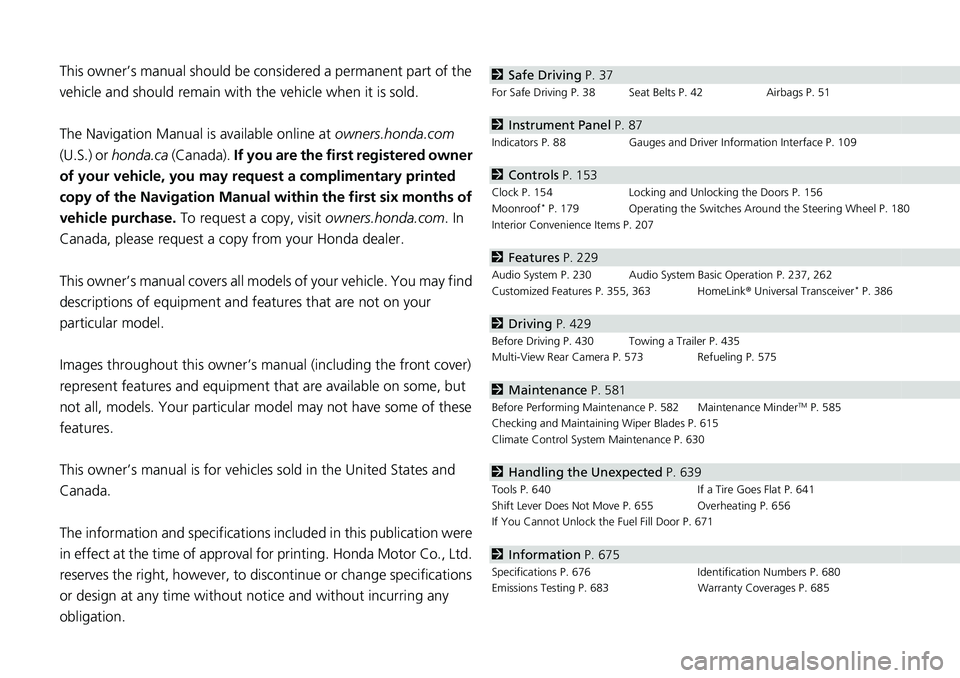
Contents
This owner’s manual should be considered a permanent part of the
vehicle and should remain with the vehicle when it is sold.
The Navigation Manual is available online at owners.honda.com
(U.S.) or honda.ca (Canada). If you are the first registered owner
of your vehicle, you may request a complimentary printed
copy of the Navigation Manual within the first six months of
vehicle purchase. To request a copy, visit owners.honda.com. In
Canada, please request a copy from your Honda dealer.
This owner’s manual covers all models of your vehicle. You may find
descriptions of equipment and features that are not on your
particular model.
Images throughout this owner’s ma nual (including the front cover)
represent features and equipment that are available on some, but
not all, models. Your particular mo del may not have some of these
features.
This owner’s manual is for vehicles sold in the United States and
Canada.
The information and specifications in cluded in this publication were
in effect at the time of approval for printing. Honda Motor Co., Ltd.
reserves the right, however, to discontinue or change specifications
or design at any time without notice and without incurring any
obligation.2 Safe Driving P. 37
For Safe Driving P. 38 Seat Belts P. 42 Airbags P. 51
2Instrument Panel P. 87
Indicators P. 88 Gauges and Driver Information Interface P. 109
2Controls P. 153
Clock P. 154 Locking and Unlocking the Doors P. 156
Moonroof* P. 179 Operating the Switches Around the Steering Wheel P. 180
Interior Convenience Items P. 207
2 Features P. 229
Audio System P. 230 Audio System Basic Operation P. 237, 262
Customized Features P. 355, 363 HomeLink ® Universal Transceiver* P. 386
2 Driving P. 429
Before Driving P. 430 Towing a Trailer P. 435
Multi-View Rear Camera P. 573 Refueling P. 575
2Maintenance P. 581
Before Performing Maintenance P. 582 Maintenance MinderTM P. 585
Checking and Maintaining Wiper Blades P. 615
Climate Control System Maintenance P. 630
2Handling the Unexpected P. 639
Tools P. 640 If a Tire Goes Flat P. 641
Shift Lever Does Not Move P. 655 Overheating P. 656
If You Cannot Unlock the Fuel Fill Door P. 671
2 Information P. 675
Specifications P. 676 Identification Numbers P. 680
Emissions Testing P. 683 Warranty Coverages P. 685
Page 10 of 700
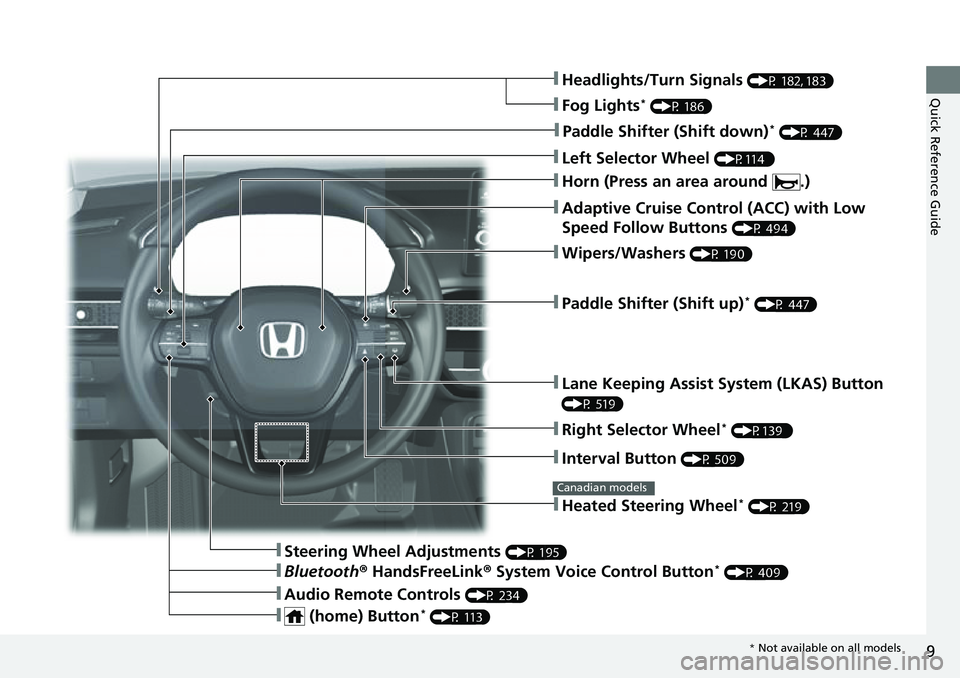
9
Quick Reference Guide❚Headlights/Turn Signals (P 182, 183)
❚Fog Lights* (P 186)
❚Paddle Shifter (Shift down)* (P 447)
❚Left Selector Wheel (P114 )
❚Adaptive Cruise Control (ACC) with Low
Speed Follow Buttons
(P 494)
❚Paddle Shifter (Shift up)* (P 447)
❚Lane Keeping Assist System (LKAS) Button
(P 519)
❚Interval Button (P 509)
❚Steering Wheel Adjustments (P 195)
❚Heated Steering Wheel* (P 219)
Canadian models
❚Wipers/Washers (P 190)
❚Right Selector Wheel* (P139 )
❚Bluetooth® HandsFreeLink ® System Voice Control Button* (P 409)
❚Audio Remote Controls (P 234)
❚ (home) Button* (P 113)
❚Horn (Press an area around .)
* Not available on all models
Page 16 of 700
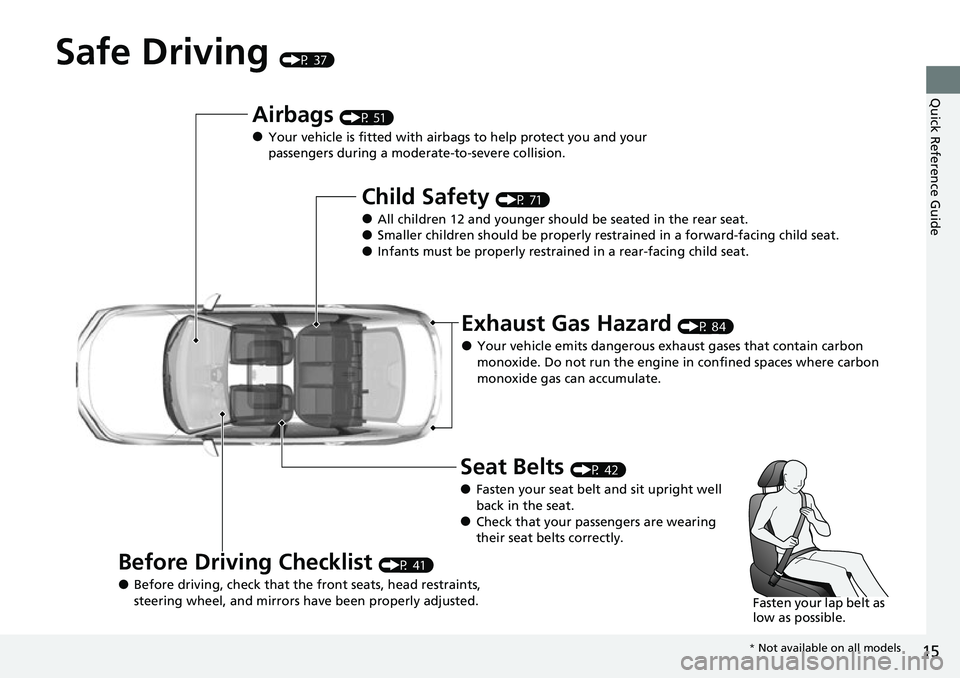
15
Quick Reference Guide
Safe Driving (P 37)
Airbags (P 51)
●Your vehicle is fitted with airbags to help protect you and your
passengers during a moderate-to-severe collision.
Child Safety (P 71)
●All children 12 and younger should be seated in the rear seat.●Smaller children should be properly restrained in a forward-facing child seat.●Infants must be properly restrained in a rear-facing child seat.
Exhaust Gas Hazard (P 84)
●Your vehicle emits dangerous exhaust gases that contain carbon
monoxide. Do not run the engine in confined spaces where carbon
monoxide gas can accumulate.
Before Driving Checklist (P 41)
●Before driving, check that the front seats, head restraints,
steering wheel, and mirrors have been properly adjusted.
Seat Belts (P 42)
●Fasten your seat belt and sit upright well
back in the seat.
●Check that your passengers are wearing
their seat belts correctly.
Fasten your lap belt as
low as possible.
* Not available on all models
Page 21 of 700
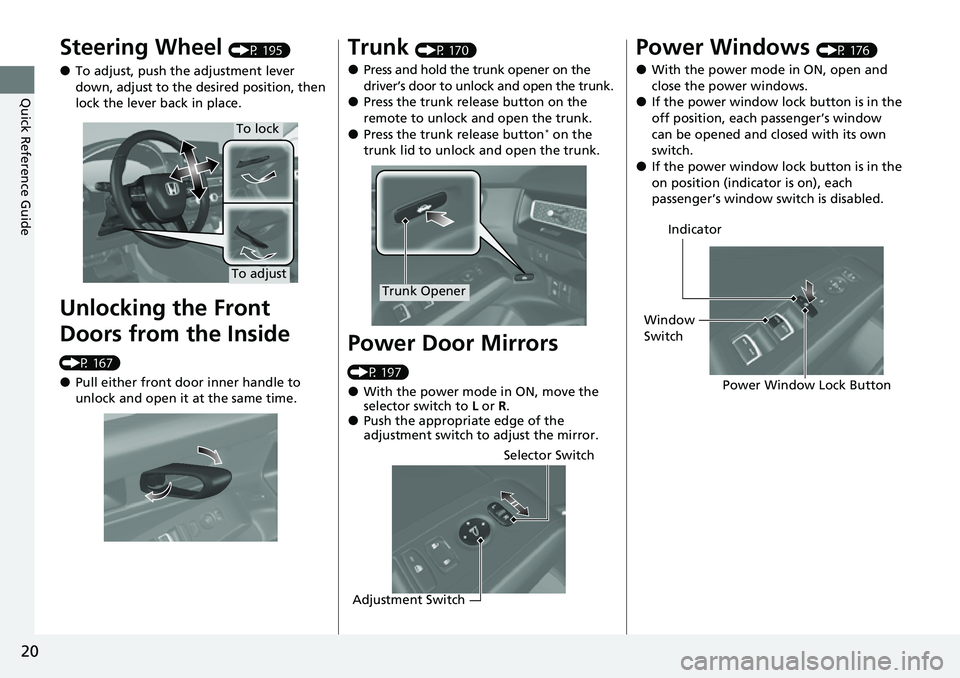
20
Quick Reference Guide
Steering Wheel (P 195)
●To adjust, push the adjustment lever
down, adjust to the desired position, then
lock the lever back in place.
Unlocking the Front
Doors from the Inside
(P 167)
●Pull either front door inner handle to
unlock and open it at the same time.
To adjust
To lock
Trunk (P 170)
●Press and hold the trunk opener on the
driver’s door to unlock and open the trunk.
●Press the trunk release button on the
remote to unlock and open the trunk.
●Press the trunk release button* on the
trunk lid to unlock and open the trunk.
Power Door Mirrors
(P 197)
●With the power mode in ON, move the
selector switch to L or R.
●Push the appropriate edge of the
adjustment switch to adjust the mirror.
Trunk Opener
Selector Switch
Adjustment Switch
Power Windows (P 176)
●With the power mode in ON, open and
close the power windows.
●If the power window lock button is in the
off position, each passenger’s window
can be opened and closed with its own
switch.
●If the power window lock button is in the
on position (indicator is on), each
passenger’s window switch is disabled.
Power Window Lock Button
Window
Switch Indicator
Page 27 of 700
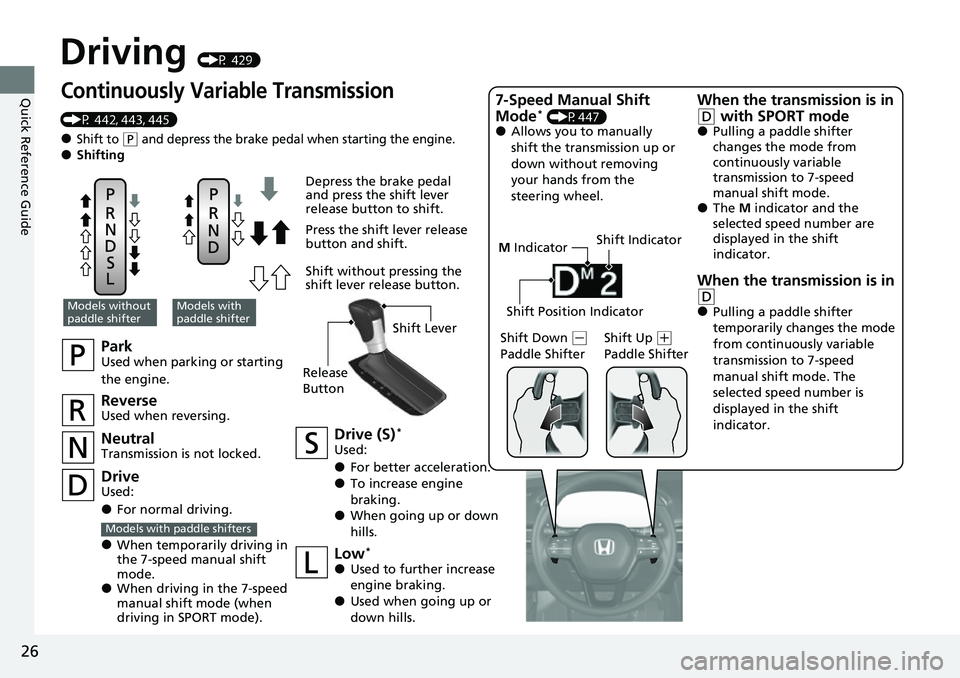
26
Quick Reference Guide
Driving (P 429)
Continuously Variable Transmission
(P 442, 443, 445)
●Shift to (P and depress the brake peda l when starting the engine.●Shifting
M Indicator
ParkUsed when parking or starting
the engine.
NeutralTransmission is not locked.
Drive (S)*
Used:
●For better acceleration.●To increase engine
braking.
●When going up or down
hills.
Models without
paddle shifterModels with
paddle shifter
Depress the brake pedal
and press the shift lever
release button to shift.
Press the shift lever release
button and shift.
Shift without pressing the
shift lever release button.
ReverseUsed when reversing.
DriveUsed:
●For normal driving.
●When temporarily driving in
the 7-speed manual shift
mode.
●When driving in the 7-speed
manual shift mode (when
driving in SPORT mode).
Models with paddle shifters
Low*
●Used to further increase
engine braking.
●Used when going up or
down hills. Shift Down
(
-
Paddle Shifter Shift Up (
+
Paddle Shifter
7-Speed Manual Shift
Mode* (P447)●Allows you to manually
shift the transmission up or
down without removing
your hands from the
steering wheel.
When the transmission is in
(D with SPORT mode●Pulling a paddle shifter
changes the mode from
continuously variable
transmission to 7-speed
manual shift mode.
●The M indicator and the
selected speed number are
displayed in the shift
indicator.
When the transmission is in (D●Pulling a paddle shifter
temporarily changes the mode
from continuously variable
transmission to 7-speed
manual shift mode. The
selected speed number is
displayed in the shift
indicator.
Release
Button Shift LeverShift Position Indicator
Shift Indicator
Page 30 of 700
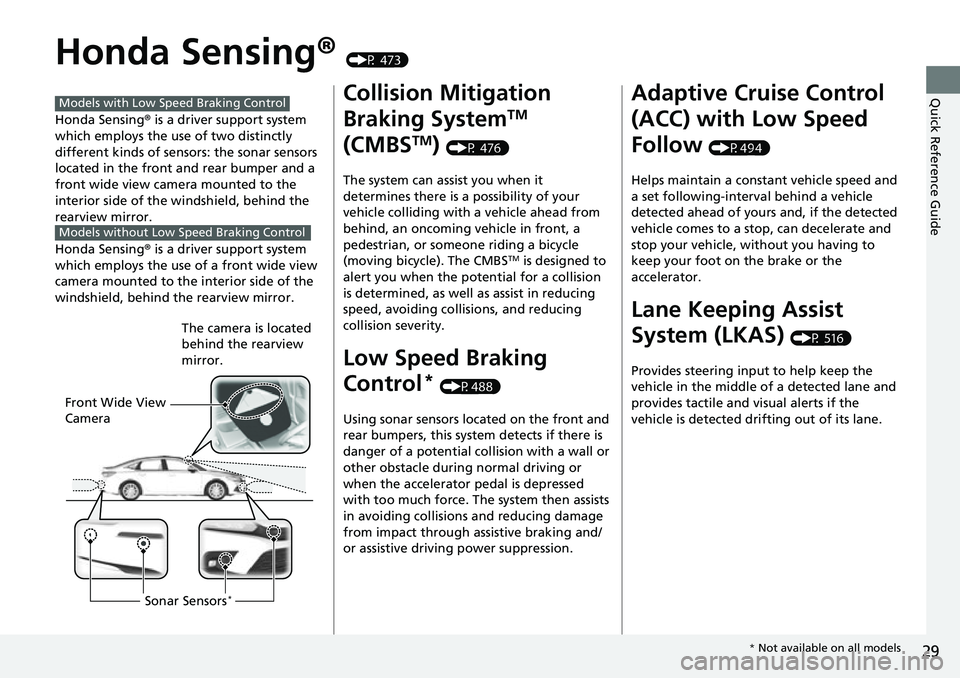
29
Quick Reference Guide
Honda Sensing® (P 473)
Honda Sensing ® is a driver support system
which employs the use of two distinctly
different kinds of sens ors: the sonar sensors
located in the front and rear bumper and a
front wide view camera mounted to the
interior side of the windshield, behind the
rearview mirror.
Honda Sensing ® is a driver support system
which employs the use of a front wide view
camera mounted to the interior side of the
windshield, behind the rearview mirror.
Models with Low Speed Braking Control
Models without Low Speed Braking Control
Front Wide View
Camera The camera is located
behind the rearview
mirror.
Sonar Sensors*
Collision Mitigation
Braking System
TM
(CMBS
TM) (P 476)
The system can assist you when it
determines there is a possibility of your
vehicle colliding with a vehicle ahead from
behind, an oncoming vehicle in front, a
pedestrian, or someone riding a bicycle
(moving bicycle). The CMBS
TM is designed to
alert you when the potential for a collision
is determined, as well as assist in reducing
speed, avoiding collisions, and reducing
collision severity.
Low Speed Braking
Control
* (P488)
Using sonar sensors located on the front and
rear bumpers, this system detects if there is
danger of a potential collision with a wall or
other obstacle during normal driving or
when the accelerator pedal is depressed
with too much force. The system then assists
in avoiding collisions and reducing damage
from impact through assistive braking and/
or assistive driving power suppression.
Adaptive Cruise Control
(ACC) with Low Speed
Follow
(P494)
Helps maintain a constant vehicle speed and
a set following-interval behind a vehicle
detected ahead of yours and, if the detected
vehicle comes to a stop, can decelerate and
stop your vehicle, without you having to
keep your foot on the brake or the
accelerator.
Lane Keeping Assist
System (LKAS)
(P 516)
Provides steering input to help keep the
vehicle in the middle of a detected lane and
provides tactile and visual alerts if the
vehicle is detected drifting out of its lane.
* Not available on all models
Page 31 of 700
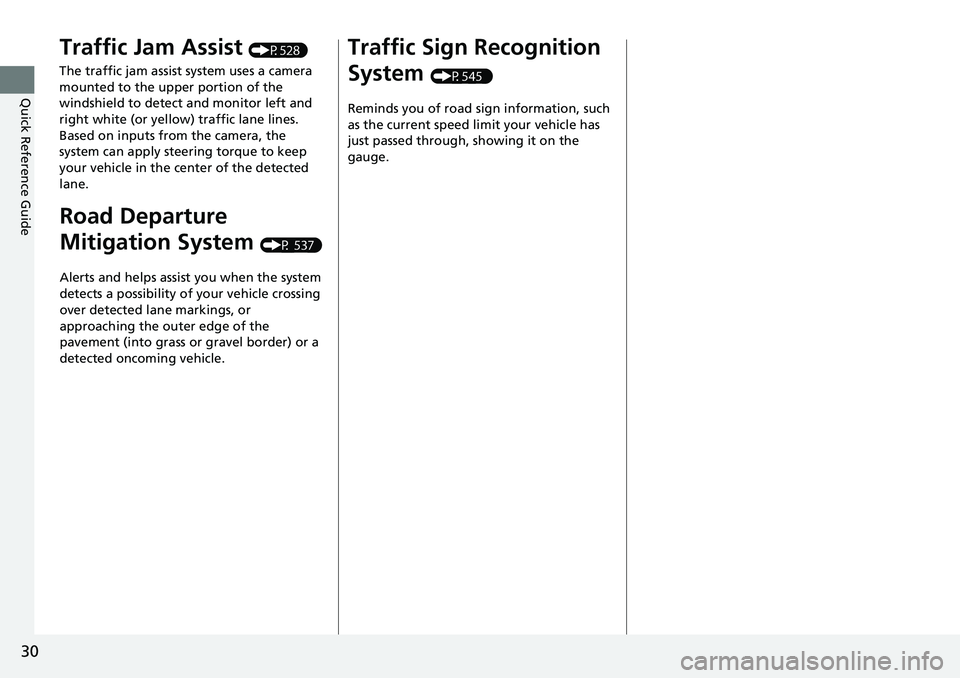
30
Quick Reference Guide
Traffic Jam Assist (P528)
The traffic jam assist system uses a camera
mounted to the uppe r portion of the
windshield to detect and monitor left and
right white (or yellow) traffic lane lines.
Based on inputs from the camera, the
system can apply steering torque to keep
your vehicle in the center of the detected
lane.
Road Departure
Mitigation System
(P 537)
Alerts and helps assist you when the system
detects a possibility of your vehicle crossing
over detected lane markings, or
approaching the outer edge of the
pavement (into grass or gravel border) or a
detected oncoming vehicle.
Traffic Sign Recognition
System
(P545 )
Reminds you of road si gn information, such
as the current speed limit your vehicle has
just passed through, showing it on the
gauge.
Page 41 of 700
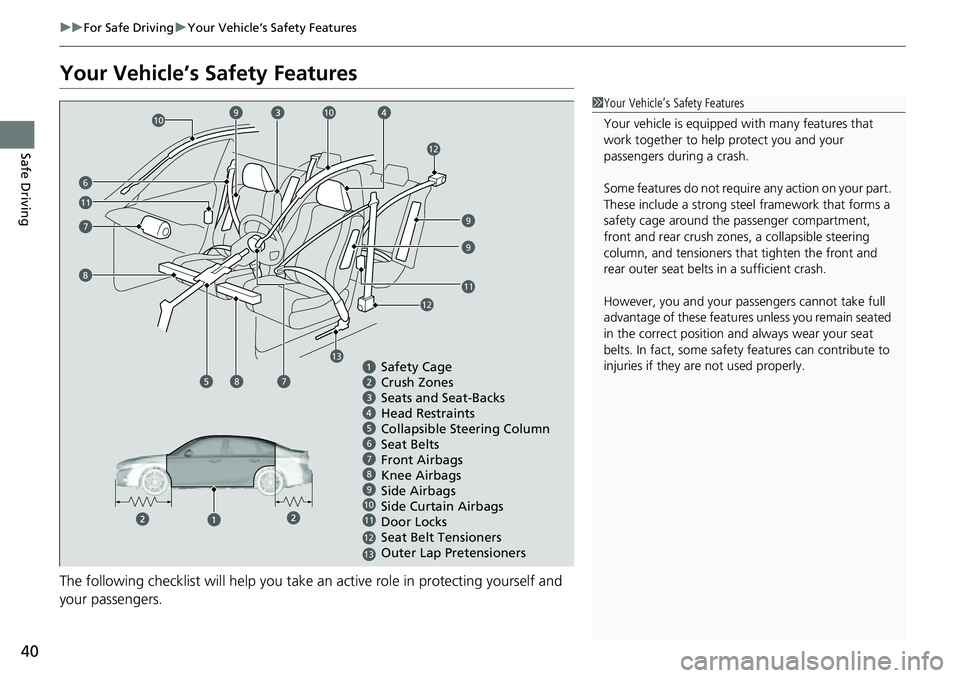
40
uuFor Safe Driving uYour Vehicle’s Safety Features
Safe Driving
Your Vehicle’s Safety Features
The following checklist will help you take an active role in protecting yourself and
your passengers.
1 Your Vehicle’s Safety Features
Your vehicle is equipped wi th many features that
work together to help protect you and your
passengers during a crash.
Some features do not require any action on your part.
These include a strong steel framework that forms a
safety cage around the passenger compartment,
front and rear crush zone s, a collapsible steering
column, and tensioners th at tighten the front and
rear outer seat belts in a sufficient crash.
However, you and your passe ngers cannot take full
advantage of these features unless you remain seated
in the correct position and always wear your seat
belts. In fact, some safety features can contribute to
injuries if they are not used properly.
67891011
Safety Cage
Crush Zones
Seats and Seat-Backs
Head Restraints
Collapsible Steering Column
Seat Belts
Front Airbags
Side Curtain Airbags
Door Locks Side Airbags
Seat Belt Tensioners7
79
9
8
10
6
11
Outer Lap Pretensioners Knee Airbags12
13
10
12
13
9
11
12
8
Page 53 of 700
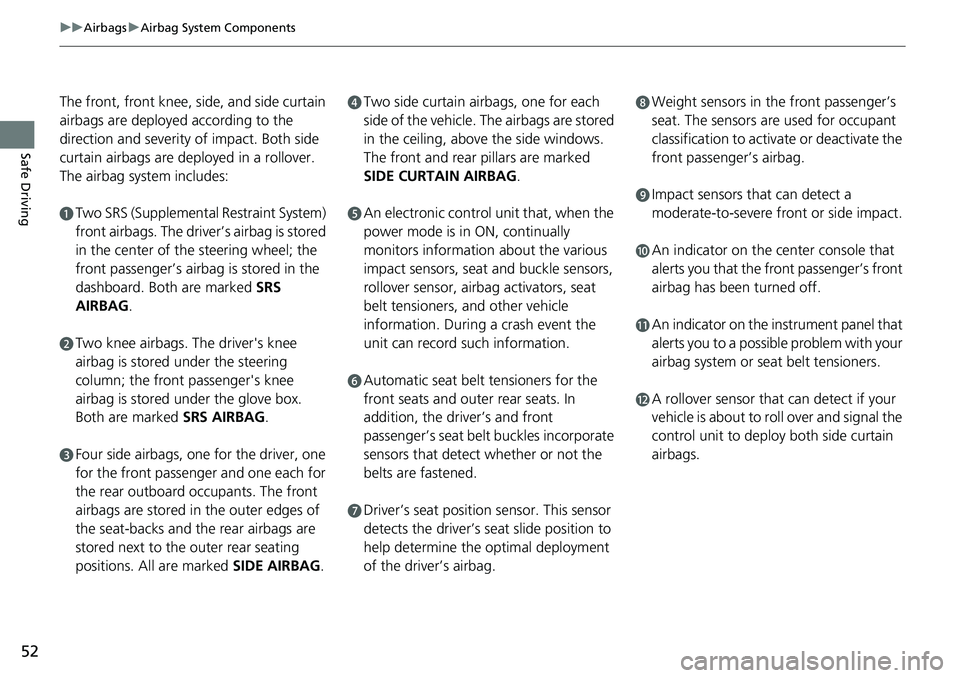
52
uuAirbags uAirbag System Components
Safe Driving
The front, front knee, si de, and side curtain
airbags are deployed according to the
direction and severity of impact. Both side
curtain airbags are depl oyed in a rollover.
The airbag system includes:
aTwo SRS (Supplemental Restraint System)
front airbags. The driver’s airbag is stored
in the center of the steering wheel; the
front passenger’s airbag is stored in the
dashboard. Both are marked SRS
AIRBAG.
bTwo knee airbags. Th e driver's knee
airbag is stored under the steering
column; the front passenger's knee
airbag is stored under the glove box.
Both are marked SRS AIRBAG.
cFour side airbags, one for the driver, one
for the front passenger and one each for
the rear outboard occupants. The front
airbags are stored in the outer edges of
the seat-backs and the rear airbags are
stored next to the outer rear seating
positions. All are marked SIDE AIRBAG.
dTwo side curtain airbags, one for each
side of the vehicle. The airbags are stored
in the ceiling, above the side windows.
The front and rear pillars are marked
SIDE CURTAIN AIRBAG .
eAn electronic control unit that, when the
power mode is in ON, continually
monitors information about the various
impact sensors, seat and buckle sensors,
rollover sensor, airbag activators, seat
belt tensioners, and other vehicle
information. During a crash event the
unit can record such information.
fAutomatic seat belt tensioners for the
front seats and outer rear seats. In
addition, the driver’s and front
passenger’s seat belt buckles incorporate
sensors that detect whether or not the
belts are fastened.
gDriver’s seat position sensor. This sensor
detects the driver’s seat slide position to
help determine the optimal deployment
of the driver’s airbag.
hWeight sensors in the front passenger’s
seat. The sensors are used for occupant
classification to activa te or deactivate the
front passenger’s airbag.
iImpact sensors that can detect a
moderate-to-severe front or side impact.
jAn indicator on the center console that
alerts you that the front passenger’s front
airbag has been turned off.
kAn indicator on the instrument panel that
alerts you to a possib le problem with your
airbag system or seat belt tensioners.
lA rollover sensor that can detect if your
vehicle is about to roll over and signal the
control unit to deploy both side curtain
airbags.
Page 54 of 700

53
uuAirbags uAirbag System Components
Safe DrivingAirbags can pose serious hazards. To do their job, airbags must inflate with
tremendous force. So, while airbags help sa ve lives, they can cause burns, bruises,
and other minor injuries, sometimes even fatal ones if occupants are not wearing
their seat belts properl y and sitting correctly.
What you should do: Always wear your seat belt properly and sit upright and as
far back from the steering wheel as possible while allowing full control of the
vehicle. A front passenger should move their seat as far back from the dashboard as
possible.
Remember, however, that no safety system ca n prevent all injuries or deaths that
can occur in a severe crash, even when s eat belts are properly worn and the airbags
deploy.
Do not place hard or sharp objects between yourself and a front airbag.
Carrying hard or sharp objects on your lap, or driving with a pipe or other sharp
object in your mouth, can result in in juries if your front airbag inflates.
Do not attach or place objects on th e front and front knee airbag covers.
Objects on the covers marked SRS AIRBAG could interfere with the proper
operation of the airbags or be propelled inside the vehicle and hurt someone if the
airbags inflate.
■Important Facts About Your Airbags1 Important Facts About Your Airbags
Do not attempt to deactivate your airbags. Together,
airbags and seat belts pr ovide the best protection.
When driving, keep hands and arms out of the
deployment path of the front airbag by holding each
side of the steering wheel. Do not cross an arm over
the airbag cover.